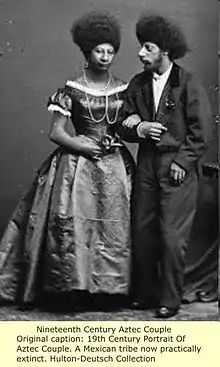

Máximo and Bartola (also known as Maximo Valdez Nunez and Bartola Velasquez respectively) were the stage names of two Salvadoran siblings both with microcephaly and cognitive developmental disability who were exhibited in human zoos in the 19th century. Originally from near Usulután, El Salvador, the siblings were given by their mother to a merchant who promised he would take them to Grenada to be educated and exhibited. They then went through several guardians afterwards. They were eventually billed as "Aztec Children" and an elaborate story was constructed of how they were found in the temple of a lost Mesoamerican city by the name of Iximaya.[1] They toured the U.S. and Europe, appearing before various regents and dignitaries.[2][3][4][5][6]
Career
Maximo and Bartola were first exhibited in the late 1840s. In 1850, they were described as being "about ten years of age" and "about eight years of age" respectively, and under the care of a Mr. Knox.[7] In Summer 1852, a custody dispute arose regarding the two of them in Philadelphia. A Grenadian man named Raymondo Selva claimed that he had been given charge of them by their parents under the condition he would provide them with an education in exchange for exhibiting them in Grenada. This occurred near the village of Jacotal in the San Miguel Department of El Salvador. Selva was placed in confinement in Grenada by authorities and custody was transferred to his brother-in-law Selazar. Selazar formed a partnership with an American named John S. Addison, and an interpreter named Pedro Salva. They were then taken to the United States. Selva by that time had been released and had claimed to have met with the parents of the children again. He promised to get the children back.[8] A Mr. J.M. Morris disputed parts of Selva's story, and claimed to have been the rightful guardian. The dispute was settled in December 1852. Custody was granted to Morris, but he was also ordered to pay Raymondo Selva $13,000.[9]
Early the next year, they toured Washington, D.C., and visited President Millard Fillmore at the White House.[10] By July 1853, they were under the guardianship of a man named Anderson, and were taken to Europe to be exhibited before Queen Victoria.[11] While in London, they were examined by biologist Richard Owen, who considered them to not be Aztecs. They were the product of the mixing of the Spanish and American Indian ancestry.[12] This led to more interest in their actual origins. Another version appeared which claimed they were the children of a mulatto woman from La Puerty located near Usulután, El Salvador. Years before, their mother exchanged them for gold with a Raimond Selva of Nicaragua. It was also claimed they had another sibling with their same condition.[13] Mr. Morris was later their guardian again and exhibited them throughout Europe.
By November 1860, Maximo and Bartola were being exhibited at Barnum's American Museum alongside Chang and Eng Bunker.[14] On January 7, 1867, the two were married in London under the names Maximo Valdez Nunez and Bartola Velasquez. J.M. Morris was still their guardian.[15] It was reported in late 1867 that the male of the pair of Aztec children had died in Charleston, South Carolina, on November 11, 1867, while on tour alongside Dan Castello's Circus and that he was buried in Magnolia Cemetery.[16] Other sources have Maximo and Bartola touring as the Aztec children together until the late 1800s.[17]
References
- ↑ c.f.The Aztec Lilliputans Archived 2022-03-20 at the Wayback Machine at 2:54.Retrieved 14 March 2022
- ↑ "Maximo and Bartola, the Aztec Children". The Human Marvels. 5 December 2007. Archived from the original on 2015-05-02. Retrieved 2015-05-07.
- ↑ Mateen, F. J., & Boes, C. J. (2010). Pinheads”: The exhibition of neurologic disorders at “The Greatest Show on Earth. Neurology, 75(22), 2028-2032.
- ↑ Bogdan, R. (2014). 14 Race, Showmen, Disability, and the Freak Show. The Invention of “Race”: Scientific and Popular Representations of Race from Linnaeus to the Ethnic Shows: Scientific and Popular Representations, 195.
- ↑ Hartzman, M. (2006). American sideshow. Penguin.
- ↑ Bogdan, R. (2012). Picturing Disability: Beggar, Freak, Citizen, and Other Photographic Rhetoric. Syracuse University Press.
- ↑ "The Aztec Children". Daily Crescent. Baton Rouge, LA. 28 December 1850. Archived from the original on 7 March 2016. Retrieved 21 August 2015.
- ↑ "The Aztecs Children". New York Times. New York, NY. 9 July 1852.
- ↑ "The Aztec Children Law Suit Settled". New York Times. New York, NY. 23 December 1852.
- ↑ "The Aztec Children". Daily Dispatch. Richmond, VA. 14 February 1853. Archived from the original on 30 October 2015. Retrieved 21 August 2015.
- ↑ "The Latest by the America". New York Times. New York, NY. 8 July 1853.
- ↑ "The Aztecs in England". Wilmington Journal. Wilmington, DE. 12 August 1853.
- ↑ "Origin of the "Aztec" Children". Western Democrat. Charlotte, NC. 7 April 1854. Archived from the original on 7 March 2016. Retrieved 21 August 2015.
- ↑ "Barnum's American Museum". New York Times. New York. 5 November 1860.
- ↑ "Marriage of the "Aztec Children"". Evening Telegraph. Philadelphia, PA. 24 January 1867. Archived from the original on 7 March 2016. Retrieved 21 August 2015.
- ↑ "Death of One of the Aztec Children". Daily Phoenix. Columbia, SC. 14 November 1867.
- ↑ Bogdan, Robert (2014). Freak Show: Presenting Human Oddities for Amusement and Profit. Chicago, IL: University of Chicago Press. p. 132. ISBN 9780226227436.